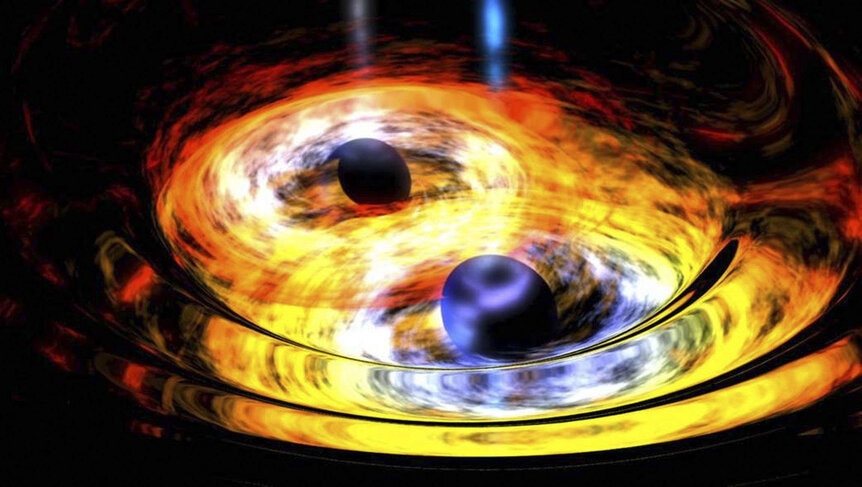Create a free profile to get unlimited access to exclusive videos, sweepstakes, and more!
Could a black hole (hypothetically) fall into a (hypothetical) wormhole, and what weirdness would happen if it did?

Black holes are already bizarre enough. In the dark vacuum of space that is anything but boring, they pull stunts like colliding into one another or ripping apart entire stars in a feeding frenzy, but what if things suddenly got a whole lot stranger and a wormhole swallowed a black hole?
No, this isn’t part of the script for a revival of Farscape. Gravitational waves emitted by black holes that have ended up on the other side of a wormhole (and possibly in another part of the universe) could prove that wormholes exist — if they actually exist. It’s not too far out, since gravitational waves have previously given away black hole collisions and neutron stars smashing into each other. The way the gravitational wave emission of a black hole changes as the black hole traverses a theoretical wormhole could end up being proof of a phenomenon that, at least for now, only happens in science fiction.
When two black holes are caught in a death spiral, the closer and faster they orbit each other, the higher the frequency of the gravitational waves coming out of them, which means the pitch of these waves keeps increasing until it becomes a “chirp.”
“For binary systems of black holes (or neutron stars), the gravitational waves take away energy, so the system falls together,” William Gabella, who co-authored a study soon to be published in General Relativity and Quantum Cosmology, told SYFY WIRE. “As they fall together, they orbit around each other faster, and faster, giving the chirp to the gravitational wave signal. It is hard to imagine any natural systems doing the opposite—starting close together in a tight, fast orbit and spiraling out and then falling back in. That is what we would see in some black hole-wormhole orbits.”
These “chirps” are what gravitational wave observatories like LIGO (Laser Interferometer Gravitational-Wave Observatory) search for when they are on the lookout for merging black holes. LIGO was the first observatory from which scientists ever observed evidence of gravitational waves. Now imagine the antithesis of a chirp. Instead of getting closer and closer, the objects would be orbiting each other further and further away, meaning pitch would decrease in an “anti-chirp.” The black hole would keep showing up in the universe over and over again, losing more energy each time until it finally ended up stuck in the throat of the wormhole.
“In one part of the universe, you would see a normal-ish gravitational wave signal from the black hole spiraling inwards (as though around another black hole), but then it would stop before the usual peak, disappear for a while as it moves into another part of the universe, and then reappear where it first surfaced,” Gabella said.
So how would the black hole even stay there? Wormholes (again, if they exist) are exotic objects. Exotic objects are made of exotic matter. Now, this is where it starts getting sci-fi. Gabella and his team believe that one possibility that could explain a black hole getting stuck in a wormhole’s throat is that the exotic matter of the wormhole would have to behave like negative mass in order for its throat to stay open. Negative mass is purely theoretical. If its existence could be proven, an object with negative mass would accelerate in the opposite direction of the force applied to it, as opposed to baryonic matter, which is matter as we know it. No exotic matter comes from black holes.
“Weirdly, black holes warp spacetime as though they had mass, but at the point, they are black holes, and no longer have matter as we know it,” explained Gabella. “We describe a general black hole by mass, spin, and charge. We do not expect an actual black hole to hold much charge for long until it attracts the opposite charge and neutralizes itself, so most black holes are described by only mass and spin. We just say it warps spacetime like it has some mass (and spin). It likely does not contain matter as we understand it.”
It still gets more alien. Spacetime in the wormhole could warp the black hole’s event horizon, making it emit warped gravitational waves. Then there is the idea of the wormhole spinning as the black hole passes through. Twisted spacetime would drag the black hole around, and as it gave off gravitational waves, it would also lose energy, producing outlandish waves. But could we detect them if they were there? Gabella thinks so.
“Existing gravitational wave detectors like LIGO could possibly detect signals consistent with black hole-wormhole orbits,” he said. “In fact, the data they have already stored could be hiding these bizarre waveforms.”



























